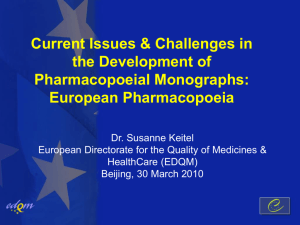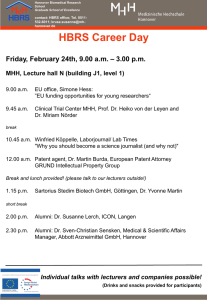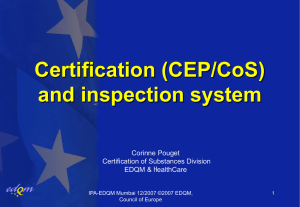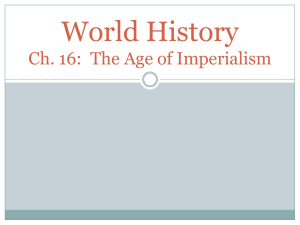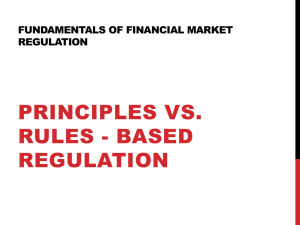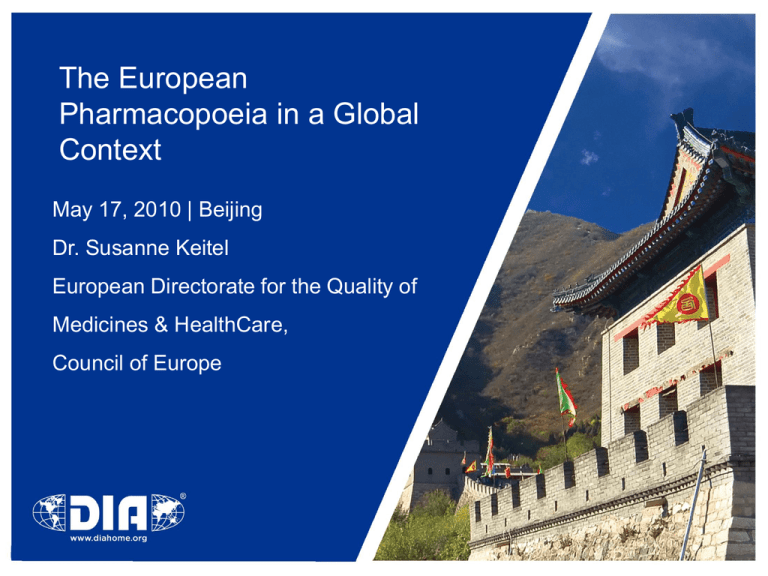
The European
Pharmacopoeia in a Global
Context
May 17, 2010 | Beijing
Dr. Susanne Keitel
European Directorate for the Quality of
Medicines & HealthCare,
Council of Europe
TOPICS
Role and History of the European
Pharmacopoeia / EDQM
Working Principles
Establishment of Monographs
Revision of Monographs
Susanne Keitel ©2011 EDQM, Council of Europe, All rights reserved
2
The Council of Europe
• Founded on 5 May 1949 by 10 countries
• An international organization in Strasbourg which
comprises 47 countries of Europe.
• The primary aim of the Council of Europe is to create
a common democratic and legal area throughout the
whole of the continent, ensuring respect for its
fundamental values: human rights, democracy and
the rule of law.
Susanne Keitel ©2011 EDQM, Council of Europe, All rights reserved
3
4
The EDQM
The European Directorate for the Quality of Medicines & HealthCare
(EDQM), a Directorate of the Council of Europe (DG Social
Cohesion)
Our vision is to be a leader in protecting public health by establishing
high quality standards for:
• medicines for human and veterinary use, blood transfusion and
organ transplantation;
• the safe and appropriate medication;
• participating in programmes targeted towards the protection of
consumer health.
Susanne Keitel ©2011 EDQM, Council of Europe, All rights reserved
5
European Pharmacopoeia Convention
S.Almeling, 26/09/10 ©2010 EDQM, Council of Europe, All rights reserved
6
Susanne Keitel ©2011 EDQM, Council of Europe, All rights reserved
From the European Pharmacopoeia..
• 1964: Activities based on an International Convention from
the Council of Europe to promote free movement of
medicines in Europe
• Mandatory status reinforced in 1975 in the EU Regulations
(Directives) – with relevance for the EEA
• 1994: EU signs the EP Convention
• 1994: creation of the European Network for Official
Medicines Control Laboratories
Susanne Keitel ©2011 EDQM, Council of Europe, All rights reserved
7
..... To The EDQM
• 1994: creation of the procedure of certification for
active substances
• 2007: transfer of activities on blood transfusion
and organ transplantation
• 2008: transfer of activities on combating
counterfeits and healthcare activities
• 2009: transfer of activities on cosmetics and foodpackaging
Susanne Keitel ©2011 EDQM, Council of Europe, All rights reserved
8
The Ph.Eur. in the World
Susanne Keitel ©2011 EDQM, Council of Europe, All rights reserved
9
European Regulatory Network
European Union
European
Medicines Agency
EMA****
London
European Union
Council
Parliament
Commission
DG Health & Consumers
Brussels
Council
of Europe
Ph. Eur.**
European
Directorate
for the Quality
Certification***
Blood Transfusion of Medicines & HealthCare
Pharmaceuticals/
Pharm. care
Organ Transplantation
*OMCL :Official Medicines Control Laboratories
**Ph.Eur : European Pharmacopoeia
***Certification : Certification of Suitability of Monographs of the European
Pharmacopoeia
****EMA : European Medicines Agency
EDQM
Strasbourg
Susanne Keitel ©2011 EDQM, Council of Europe, All rights reserved
OMCL*
Network
10
European Pharmacopoeia
• Protecting public health - one common compulsory standard
• THE official pharmacopoeia in Europe – complemented by
national pharmacopoeias for texts of interest to only one
Member State
• Mandatory at the same date in 36 Member States (CoE) and
the EU (decision of Ph. Eur. Commission).
• Legally binding quality standards for ALL medicinal products
in the EU, i.e. raw material, preparations, dosage forms,
containers must comply with the Ph. Eur. requirements when
they exist.
KEITEL©2010
EDQM,
All rights reserved
SusanneSusanne
Keitel ©2011
EDQM, Council
of Council
Europe,ofAllEurope,
rights reserved
11
Parties Involved
The European Pharmacopoeia Commission
The National Pharmacopoeia authorities
The Groups of Experts and Working Parties
The EDQM / Technical Secretariat
The Stakeholders
Susanne Keitel ©2011 EDQM, Council of Europe, All rights reserved
12
Ph. Eur. Commission
Decision making body of the European Pharmacopoeia
Up to 3 delegates for each
member country
1 delegate for each Observer
Susanne Keitel ©2011 EDQM, Council of Europe, All rights reserved
13
Role of the Ph.Eur. Commission
To determine the general principles applicable to
the elaboration of the Pharmacopoeia
To decide upon methods of analysis for that
purpose
To define and adopt the work programme
To recommend the implementation dates of the
Pharmacopoeia
To appoint chairs and members of expert groups
and working parties
Susanne Keitel ©2011 EDQM, Council of Europe, All rights reserved
14
Observers to the Commission
• Admittance of Observers from :
– Member States of the CoE that are not part of
the Convention
– States that are not Members of the CoE
– International governmental organisations
Decided by unanimous vote of the
Commission
Susanne Keitel ©2011 EDQM, Council of Europe, All rights reserved
15
National Pharmacopoeia
Authorities
• Usually, the Secretariat of the National
Pharmacopoeia Commission, or if missing,
the National Competent Authority
– Appoint delegates to the Commission
– Nominate experts to groups of experts/working
parties
– Implement the European Pharmacopoeia
– Provide the necessary funding
Susanne Keitel ©2011 EDQM, Council of Europe, All rights reserved
16
The Groups of Experts
Currently 20 permanent Expert Groups and
48 Working Parties (more than 250 meeting days/year)
Task:
To draft and verify the monographs and general methods
Composition:
• Experts from universities, industries, licensing authorities and
Official Medicines Control Laboratories
• Up to one expert per member country, chosen on the sole basis of
his/her scientific competence
• Additional specialists, where needed
• Meet 2 to 3 times a year
17
The Purpose of the
European Pharmacopoeia
• To promote public health by the provision of
recognised common standards. Such standards
are to be for the safe use of medicines by patients
and consumers.
• Their existence:
— facilitates the free movement of medicinal products
in Europe;
— ensures the quality of medicinal products and their
components imported into or exported from Europe.
Susanne Keitel ©2011 EDQM, Council of Europe, All rights reserved
18
The Principles
• Elaboration and approval of monographs and other texts
proceeds through an efficient and transparent, smoothrunning process, based on scientific co-operation
between the members of the various Groups of Experts
and Working Parties assigned by the European
Pharmacopoeia Commission, the governing body of the
Pharmacopoeia.
Susanne Keitel ©2011 EDQM, Council of Europe, All rights reserved
19
The Principles
• Experts give of their time, expertise and experience
to produce the highest-level quality standards
available to the public, standards that are
continually revised in line with scientific
developments. This co-operation between experts
from regulatory authorities and official government
laboratory scientists, academia and industry
represents the pinnacle of scientific co-operation to
produce a high standard of technical monographs
and chapters.
Susanne Keitel ©2011 EDQM, Council of Europe, All rights reserved
20
The Principles
• Furthermore, the technical requirements
adopted by the Pharmacopoeia Commission
are based upon a unanimous decisionmaking process – each Member State of the
Pharmacopoeia Commission has the right to
veto, should they choose to exercise it.
Susanne Keitel ©2011 EDQM, Council of Europe, All rights reserved
21
Contents of the Ph. Eur.
More than 2200 monographs
Fats
dosage forms
Herbals
Radiopharm.
Human
vaccines
Vet. Vaccines
Plastics
Chemicals
Blood deriv.
Antibiotics
Gases
homeopathy
biologicals
22
Basis for Monographs
• Monographs must take account of all currently
approved products
• Approved specification(s) are the main basis
backed up by batch data
• Draft monographs are checked by regulatory
authorities at Pharmeuropa stage
• Close collaboration between European
Pharmacopoeia and European Licensing Authorities
defined in EU Pharmaceutical Legislation (e.g.
Directive 2001/83/EC)
• Policy for monograph development is given in the
Technical Guide for the Elaboration of Monographs
(available on web site)
Susanne Keitel ©2011 EDQM, Council of Europe, All rights reserved
23
Creation or Revision of a Text
Request of creation / revision
Approval by
the
Commission
Allocation to
a Working
Procedure
Publication
Text
approved by
the
Commission
Overall timescale:
2-3 years
Assignment
to a Group
of expert
Public
enquiry
Creation /
revision of
the text by
the Group
Susanne Keitel ©2011 EDQM, Council of Europe, All rights reserved
24
Notification of National
Monographs
• According to the Guide for Work, delegations must notify
the Commission of any creation/revision of National
Monographs that may be within the scope of the Ph. Eur.:
– Information is sent by the NPA to the Secretariat.
– Proposals are then distributed by the Secretariat to all
delegations.
– Item added to the work programme:
• If at least 2 delegations are interested,
• If the text is within the scope of the Ph. Eur.
• If no delegation is opposed to it.
Susanne Keitel ©2011 EDQM, Council of Europe, All rights reserved
25
New Monographs
• Addition to programme depends on:
– therapeutic importance
– extent of use
– number of countries in which product is approved
– known quality problems
Susanne Keitel ©2011 EDQM, Council of Europe, All rights reserved
26
Revision: Why?
• Impact of globalisation: new sources (may) have new
impurity profiles
• Revision requests from European Licensing Authorities
or the EDQM Certification Division (CEP)
• New quality issues arise
• Analytical methods change: more convenient methods,
more powerful methods, more reliable methods
become available
• International harmonisation (PDG, ICH, VICH)
Susanne Keitel ©2011 EDQM, Council of Europe, All rights reserved
27
How Standards Are Regularly Reviewed
and Revised To Stay ‘State of The Art’
Increased demand for
Generic and Biosimilar
products
Developments in
Regulatory
Environment
e.g. Guidelines,
ICH Q8/Q9/Q10/Q11, REACH
e.g. New sources
Need to regularly
review and update
Ph Eur texts _
need to create
new texts
Scientific / technical
evolutions
New risks to
Public Health
e.g. Genotoxic impurities,
TSE, contamination/
falsification (heparins)
e.g. Fast LC, NIR, PAT,
new molecules, new
therapies e.g. CT
Developments in
Manufacture and
Globalisation
e.g. continuous
manufacturing, changed
routes of synthesis
28
Pharmeuropa
• is the European Pharmacopoeia Forum containing draft
monographs and texts for public comment
• 4 issues per year
• 4 comment deadlines per year
• As of Jan 2012, i.e. Pharmeuropa 24.1, will be paperless and
free
• Texts will be published on ongoing basis, while comment
deadlines will stay as before
• Trial period (both online and print available):
– 23.3 and 23.4 access for ANPs
– 23.4 access for general public
Susanne Keitel ©2011 EDQM, Council of Europe, All rights reserved
29
30
Publication and Implementation
• The text is first published in Pharmeuropa for
information and posted on the EDQM website.
• Ph. Eur. texts are implemented usually 1 year
after adoption by the Commission and about 6
months after publication.
• Ph. Eur.: 3 supplements per year and 1 new
edition every 3 years.
Susanne Keitel ©2011 EDQM, Council of Europe, All rights reserved
31
Reference Standards
• Most monographs require at least one reference
standard
• The reference standard underpins the quality standard
• Established and monitored by the EDQM Laboratory
• Produced and distributed by the Reference Standards
Division
2200 reference standards
• Since 2010, EDQM is also responsible for WHO’s ICRS
portfolio
Susanne Keitel ©2011 EDQM, Council of Europe, All rights reserved
ouncil of Europe, All rights reserved
32
Ph. Eur. International Activities
• 36 European Member States and EU
• 22 observer countries and WHO
• MoU‘s and Confidentiality Agreements
with NIFDC, FDA, TGA....
• Pharmacopoeial Discussion Group (PDG)
• Collaboration in the establishment of
reference standards
• ....
33
Key Documents
• Convention on the Elaboration of a European
Pharmacopoeia http://www.edqm.eu/medias/fichiers/1964_PhEur_Convention_English.pdf
• Protocol to the Convention on the Elaboration of a
European Pharmacopoeia
http://www.edqm.eu/medias/fichiers/1994_Protocol_PhEur_English.pdf
• Rules of Procedure of the European Pharmacopoeia
Commission http://www.edqm.eu/medias/fichiers/Rules_of_Procedure_of_the_European_Pharmacopoeia_C.pdf
• Guide for the Work of the European Pharmacopoeia
http://www.edqm.eu/medias/fichiers/PAPHSG_10_42_DEF_Guide_for_the_work_of_the_Europea.pdf
• Code of Practice for the Work of the European
Pharmacopoeia
http://www.edqm.eu/medias/fichiers/Code_of_Practice_for_the_Work_of_the_European_Phar.pdf
Susanne Keitel ©2011 EDQM, Council of Europe, All rights reserved
34

